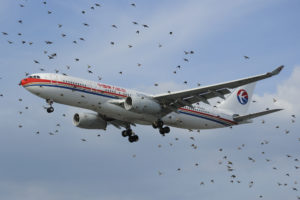 The most dangerous part of a plane when it comes to bird strikes is the engine.
The most dangerous part of a plane when it comes to bird strikes is the engine.
Generally, bird strikes are a hit-and-run situation with smaller birds disappearing into engines and larger birds usually causing minimal damage to hulls, engines, or plane noses. The force will sometimes crack windshields, leaving dings and bumps on the plane.
Nearly 500 planes have been damaged by collisions with birds since 2000, according to the Federal Aviation Administration. Some 166 of those planes had to make emergency landings.
Birds can often get sucked into engines on takeoff, disabling the planes and forcing pilots to make emergency landings or crash.
Experts say bird strikes are an increasingly serious problem. They cause an estimated $600 million a year in damage to planes.
Flocks of birds are especially dangerous and can lead to multiple strikes, and damage. Bird strikes happen most often during takeoff or landing of the flight. However, bird strikes have also been reported at high altitudes, some as high as 6,000 m (20,000 ft) to 9,000 m (30,000 ft) above the ground.
“There’s a variety of ways a bird can take down an airplane,” Birds can disable planes, by flying into the engines and shutting them down. They can also penetrate the windshield or other parts of the engine, causing pilots to lose control. And apparently, when it comes to collisions with birds, size doesn’t always matter.
Most of the time pilots and passengers may have no clue that they hit a bird until they leave the plane and see a dent. In a small percentage of bird strikes, damage occurs, and in an even smaller percentage, there’s catastrophic damage.
The cost of repairing an aircraft damaged by a bird strike can vary from very little to millions of dollars when an aircraft is lost.
A tentative and probably conservative estimate of US$1.2 billion per year in damage and delays is the outcome of this calculation.
]Evidence on bird nuisance,
Flight engine damaged by bird leads to cancellation, loss of Rs 5 crore estimated
UPDATED: June 8, 2018, 10:48 IST
A GoAir flight flying to Port Blair from Kolkata had to return to the airport after a bird strike left the airplane’s engine damaged on Thursday morning.
With 160 passengers onboard, GoAir flight G8-101 was taking off around 8:30 am but was asked to come back to the airport after the pilot experienced heavy vibrations in the right engine during lift-off.
The pilot observed that the vibrations had crossed its threshold level. After the pilot did not send a call sign, air traffic control contacted him for confirmation. After the pilot informed them about the vibrations, the plane was called back to the airport.
At the air traffic control, officials suspected that something was wrong on the flight as the captain had not yet reported the call sign by which the aircraft is identified on the radar screen.
The engineers revealed that the bird had damaged six engine blades. The flight was ultimately canceled.
The damage cost is expected to be around Rs 5 crore.
Turkish Airlines plane makes the emergency landing in Kenya after the bird strike
OCTOBER 13, 2017, 11:03 AM
MOMBASA, Kenya (Reuters) – A Turkish Airlines jet carrying 121 passengers and six crew made an emergency landing in Kenya on Friday after one of its engines sucked in a bird, police said.
Flight TK 673 was leaving Kenya’s coastal city of Mombasa for Istanbul when the bird strike happened at around 4 a.m. The plane circled around Mombasa for an hour to empty its fuel tank before it landed.
No one injured. The plane was checked by technicians and took off again.
There is a solution with C Tech Corporation to keep the birds away from perching and roosting.
CombirepelTM Bird repellent lacquer is the product produced by C Tech Corporation to prevent the menace caused by birds. This product is specially designed to prevent bird perching and roosting.
It is available in the form of concentrate lacquer. The product causes the bird’s pain receptors associated with taste. Some birds use their sense of smell through which they recognize that the product is a threat. The product is specially designed to prevent perching and roosting of birds. Repellent evokes a physiological effect which the birds associated with sensory cue and then learn to avoid it.
The product is anti-corrosive and water resistant and has no effect of UV light. The product is transparent and is compatible with most of the surfaces which are easy to apply.
Thus using the bird’s sensory mechanism we can get rid of them without causing them any physical harm.
Contact us at technical.marketing@ctechcorporation.com to keep the pests away.
Also, visit our websites:
1] http://www.ctechcorporation.com/
2] http://www.rodrepel.com/
3] http://www.termirepel.com/
4] http://www.combirepel.com/
Follow our Facebook pages at:
1] https://www.facebook.com/Combirepel-411710912249274/
2] https://www.facebook.com/Termirepel-104225413091251/
3] https://www.facebook.com/Rodrepel-120734974768048/
Follow us on our Twitter pages at:
1] https://twitter.com/rodrepel
2] https://twitter.com/termirepel
3] https://twitter.com/combirepel
